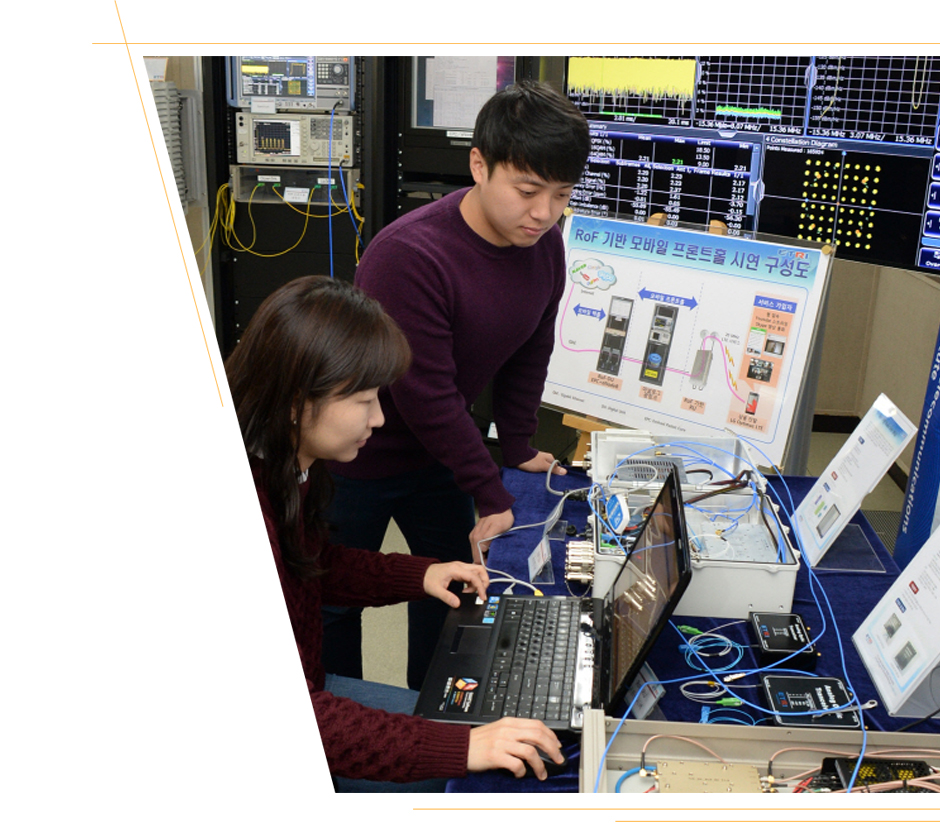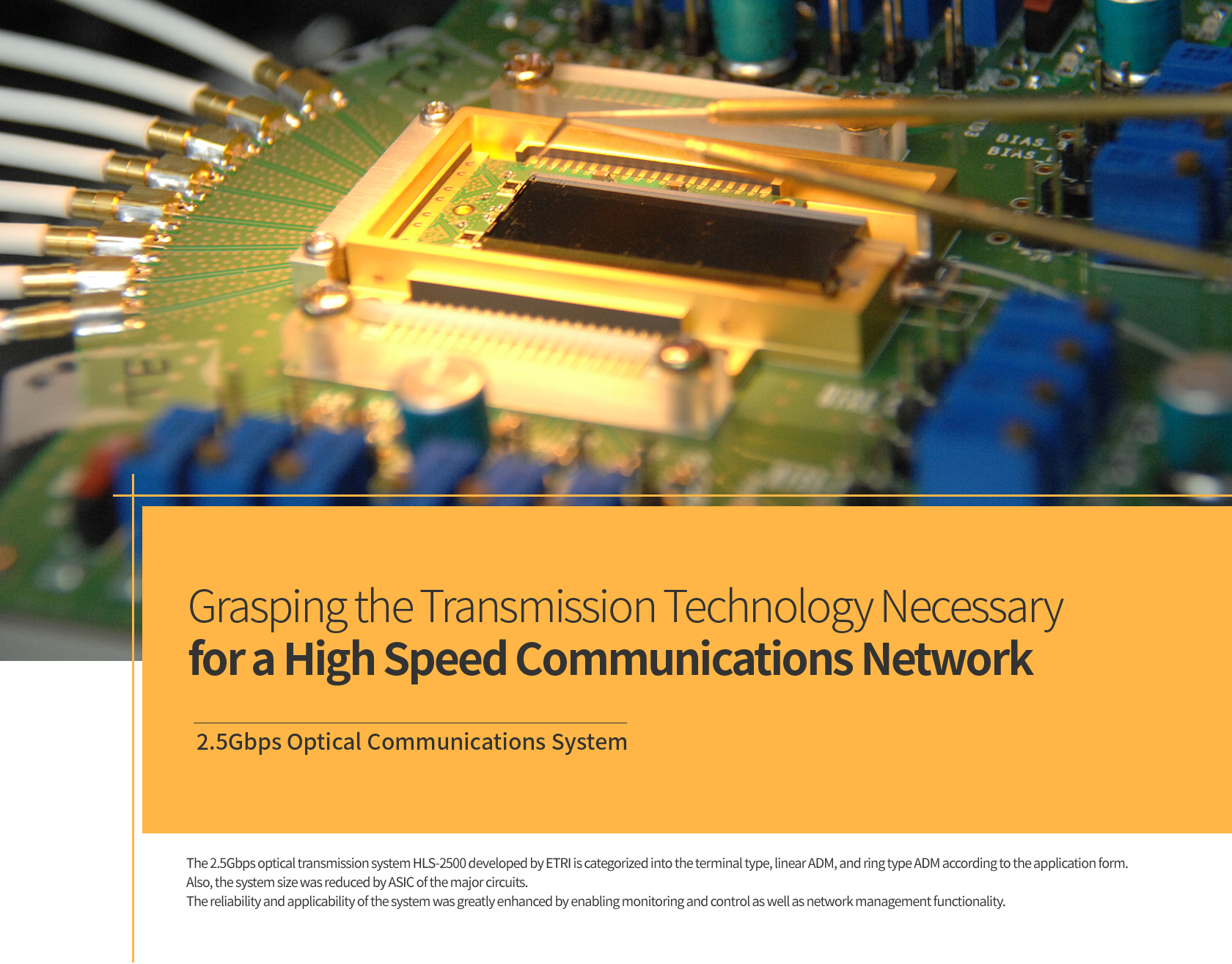
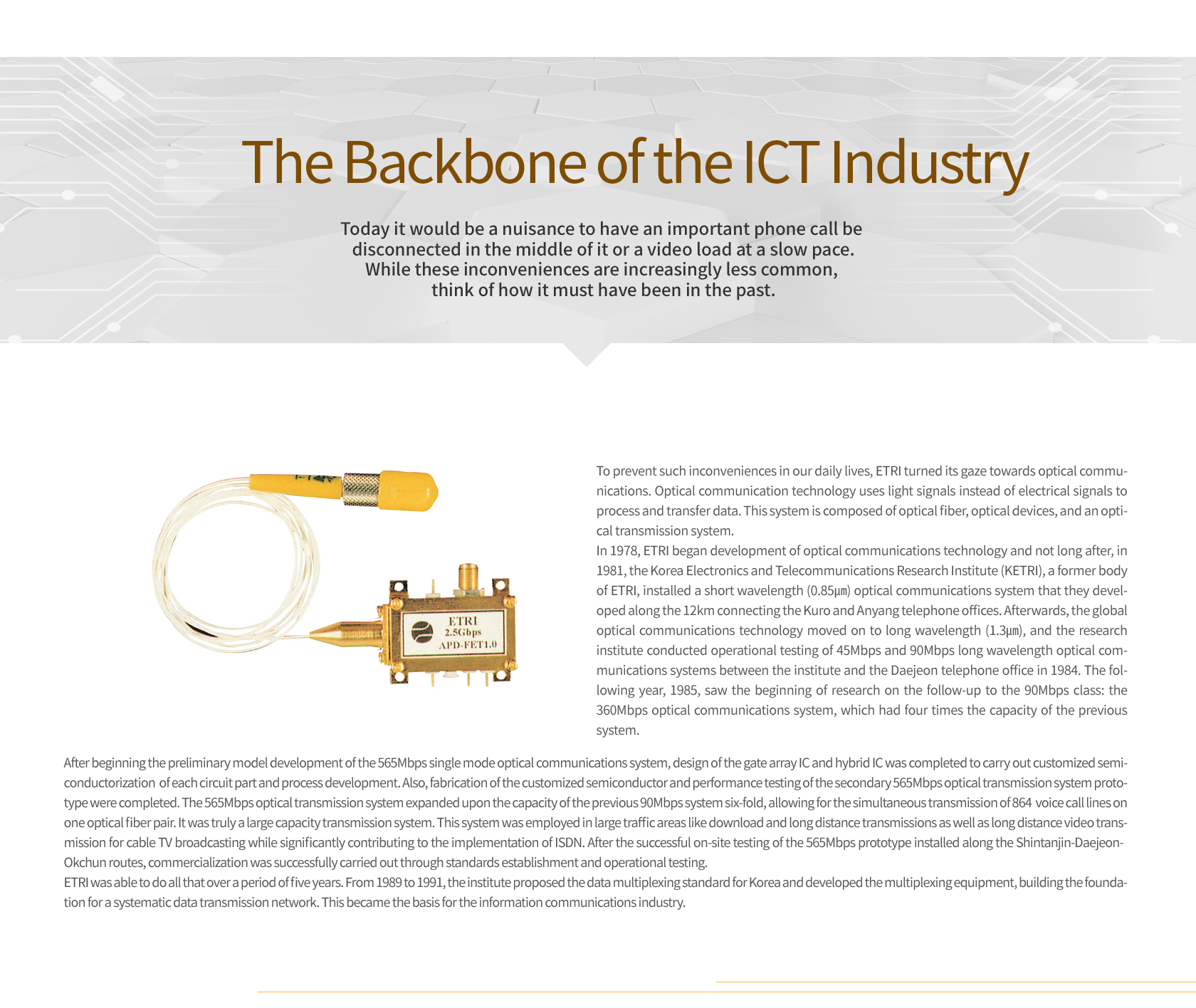
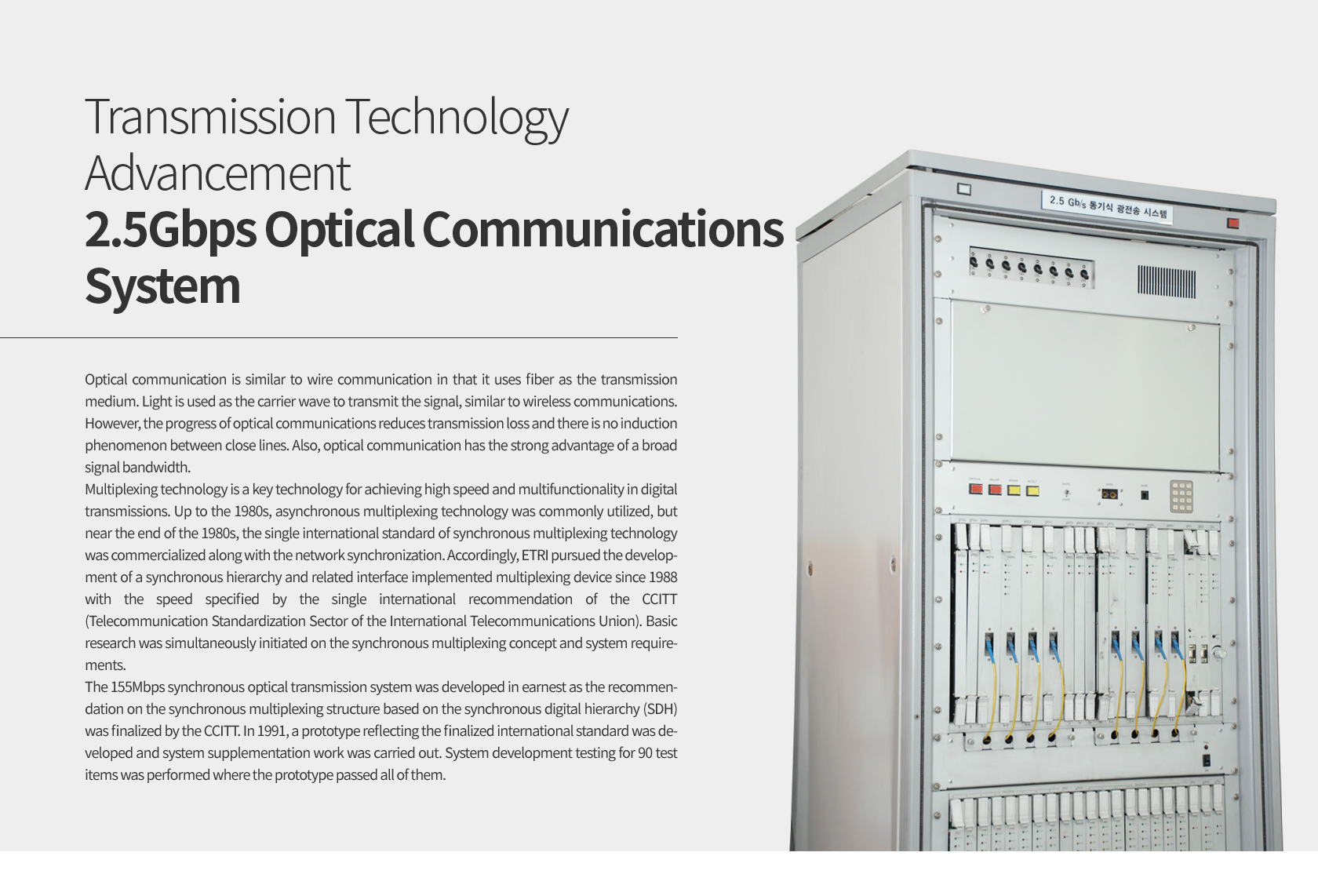
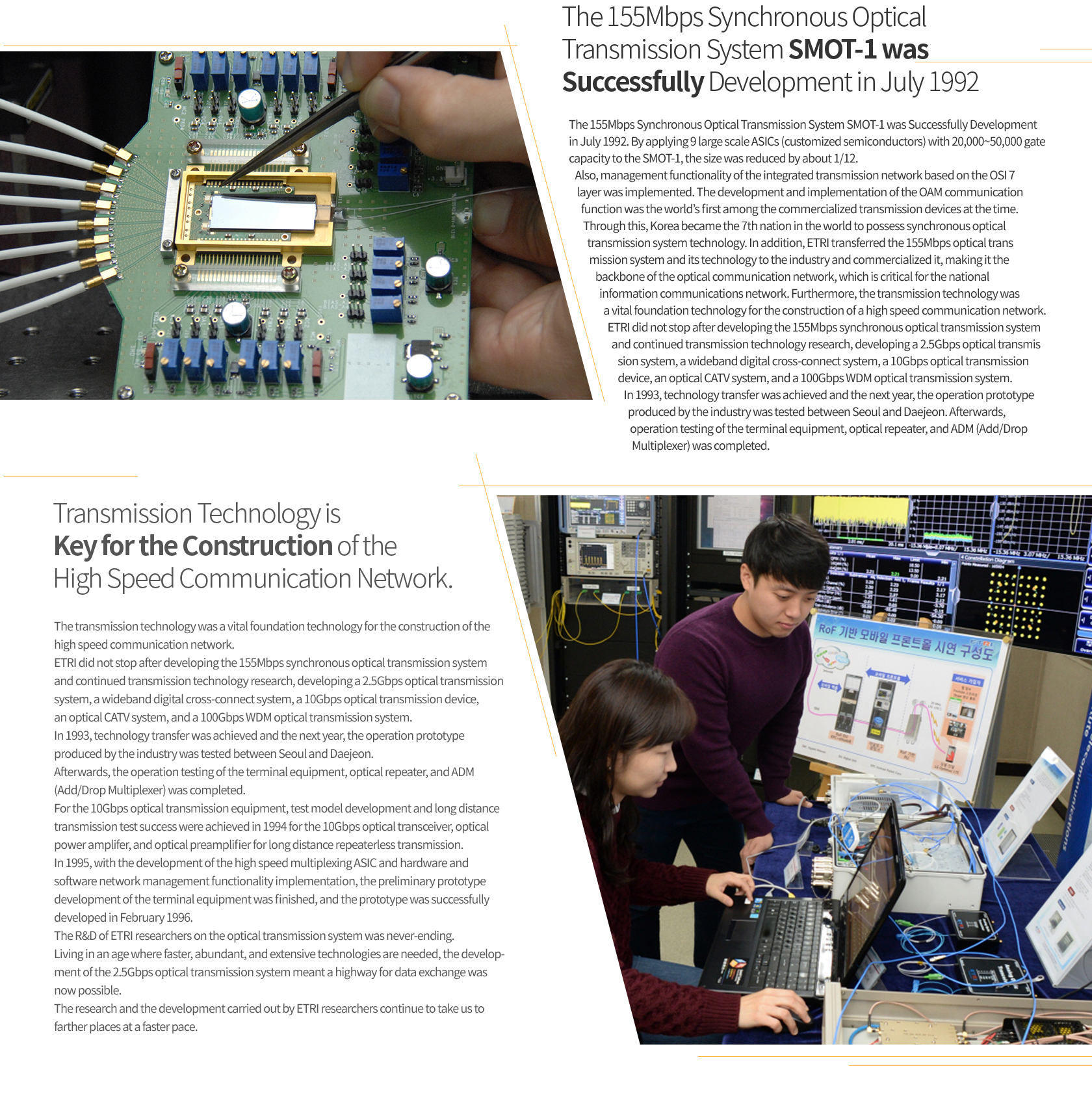
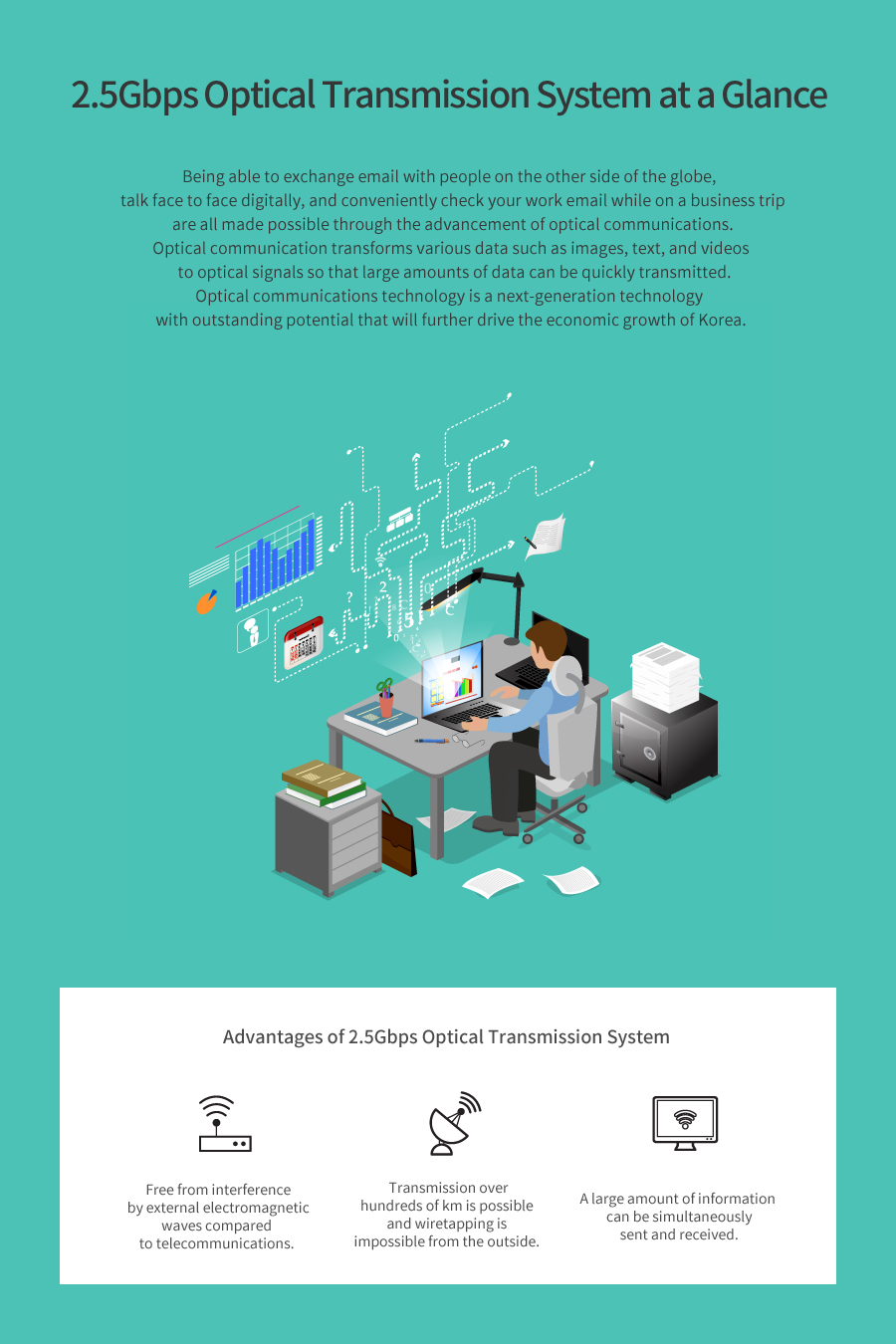
List of 40 Key Research Accomplishments
for a High Speed Communications Network
2.5Gbps Optical Communications System
The 2.5Gbps optical transmission system HLS-2500 developed by ETRI is categorized into the terminal type, linear ADM, and ring type ADM according to the application form. Also, the system size was reduced by ASIC of the major circuits. The reliability and applicability of the system was greatly enhanced by enabling monitoring and control as well as network management functionality.
01
The Backbone of the
ICT Industry
Today it would be a nuisance to have an important phone call be disconnected in the middle of it or a video load at a slow pace. While these inconveniences are increasingly less common, think of how it must have been in the past.
To prevent such inconveniences in our daily lives, ETRI turned its gaze towards optical communications. Optical communication technology uses light signals instead of electrical signals to process and transfer data. This system is composed of optical fiber, optical devices, and an optical transmission system.
In 1978, ETRI began development of optical communications technology and not long after, in 1981, the Korea Electronics and Telecommunications Research Institute (KETRI), a former body of ETRI, installed a short wavelength (0.85㎛) optical communications system that they developed along the 12km connecting the Kuro and Anyang telephone offices. Afterwards, the global optical communications technology moved on to long wavelength (1.3㎛), and the research institute conducted operational testing of 45Mbps and 90Mbps long wavelength optical communications systems between the institute and the Daejeon telephone office in 1984. The following year, 1985, saw the beginning of research on the follow-up to the 90Mbps class: the 360Mbps optical communications system, which had four times the capacity of the previous system.
After beginning the preliminary model development of the 565Mbps single mode optical communications system, design of the gate array IC and hybrid IC was completed to carry out customized semiconductorization of each circuit part and process development. Also, fabrication of the customized semiconductor and performance testing of the secondary 565Mbps optical transmission system prototype were completed. The 565Mbps optical transmission system expanded upon the capacity of the previous 90Mbps system six-fold, allowing for the simultaneous transmission of 864 voice call lines on one optical fiber pair. It was truly a large capacity transmission system. This system was employed in large traffic areas like download and long distance transmissions as well as long distance video transmission for cable TV broadcasting while significantly contributing to the implementation of ISDN. After the successful on-site testing of the 565Mbps prototype installed along the Shintanjin-Daejeon-Okchun routes, commercialization was successfully carried out through standards establishment and operational testing.
ETRI was able to do all that over a period of five years. From 1989 to 1991, the institute proposed the data multiplexing standard for Korea and developed the multiplexing equipment, building the foundation for a systematic data transmission network. This became the basis for the information communications industry.
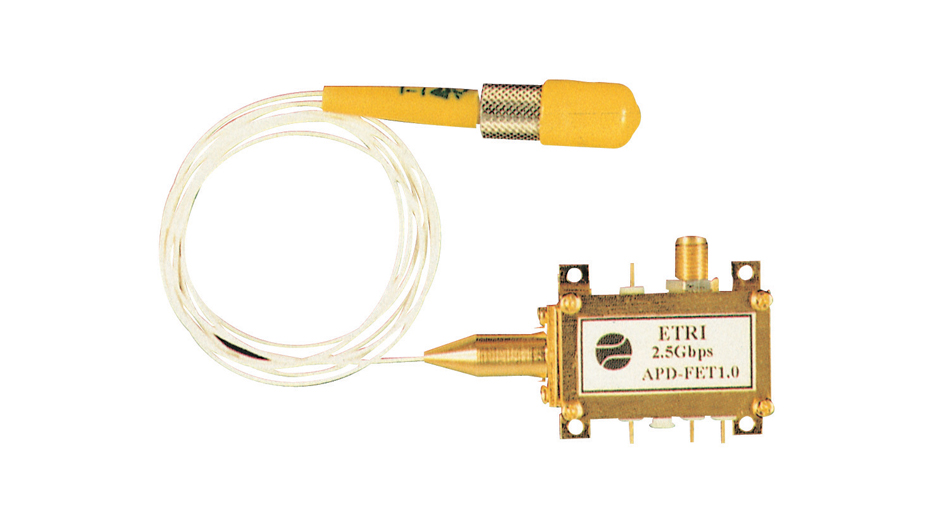
02
Transmission Technology Advancement
2.5Gbps Optical Communications System
Optical communication is similar to wire communication in that it uses fiber as the transmission medium. Light is used as the carrier wave to transmit the signal, similar to wireless communications. However, the progress of optical communications reduces transmission loss and there is no induction phenomenon between close lines. Also, optical communication has the strong advantage of a broad signal bandwidth.
Multiplexing technology is a key technology for achieving high speed and multifunctionality in digital transmissions. Up to the 1980s, asynchronous multiplexing technology was commonly utilized, but near the end of the 1980s, the single international standard of synchronous multiplexing technology was commercialized along with the network synchronization. Accordingly, ETRI pursued the development of a synchronous hierarchy and related interface implemented multiplexing device since 1988 with the speed specified by the single international recommendation of the CCITT (Telecommunication Standardization Sector of the International Telecommunications Union). Basic research was simultaneously initiated on the synchronous multiplexing concept and system requirements.
The 155Mbps synchronous optical transmission system was developed in earnest as the recommendation on the synchronous multiplexing structure based on the synchronous digital hierarchy (SDH) was finalized by the CCITT. In 1991, a prototype reflecting the finalized international standard was developed and system supplementation work was carried out. System development testing for 90 test items was performed where the prototype passed all of them.

The 155Mbps Synchronous Optical Transmission System SMOT-1 was Successfully Development in July 1992. By applying 9 large scale ASICs (customized semiconductors) with 20,000~50,000 gate capacity to the SMOT-1, the size was reduced by about 1/12. Also, management functionality of the integrated transmission network based on the OSI 7 layer was implemented. The development and implementation of the OAM communication function was the world’s first among the commercialized transmission devices at the time. Through this, Korea became the 7th nation in the world to possess synchronous optical transmission system technology. In addition, ETRI transferred the 155Mbps optical transmission system and its technology to the industry and commercialized it, making it the backbone of the optical communication network, which is critical for the national information communications network. Furthermore, the transmission technology was a vital foundation technology for the construction of a high speed communication network.
ETRI did not stop after developing the 155Mbps synchronous optical transmission system and continued transmission technology research, developing a 2.5Gbps optical transmission system, a wideband digital cross-connect system, a 10Gbps optical transmission device, an optical CATV system, and a 100Gbps WDM optical transmission system. In 1993, technology transfer was achieved and the next year, the operation prototype produced by the industry was tested between Seoul and Daejeon. Afterwards, operation testing of the terminal equipment, optical repeater, and ADM (Add/Drop Multiplexer) was completed.
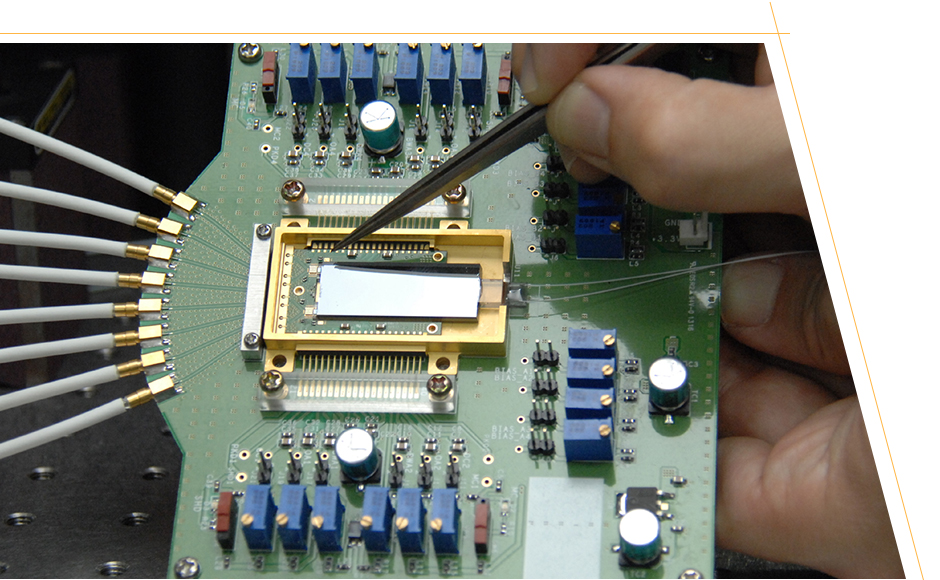
The transmission technology was a vital foundation technology for the construction of the high speed communication network. ETRI did not stop after developing the 155Mbps synchronous optical transmission system and continued transmission technology research, developing a 2.5Gbps optical transmission system, a wideband digital cross-connect system, a 10Gbps optical transmission device, an optical CATV system, and a 100Gbps WDM optical transmission system. In 1993, technology transfer was achieved and the next year, the operation prototype produced by the industry was tested between Seoul and Daejeon. Afterwards, the operation testing of the terminal equipment, optical repeater, and ADM (Add/Drop Multiplexer) was completed.
For the 10Gbps optical transmission equipment, test model development and long distance transmission test success were achieved in 1994 for the 10Gbps optical transceiver, optical power amplifer, and optical preamplifier for long distance repeaterless transmission. In 1995, with the development of the high speed multiplexing ASIC and hardware and software network management functionality implementation, the preliminary prototype development of the terminal equipment was finished, and the prototype was successfully developed in February 1996.
The R&D of ETRI researchers on the optical transmission system was never-ending. Living in an age where faster, abundant, and extensive technologies are needed, the development of the 2.5Gbps optical transmission system meant a highway for data exchange was now possible. The research and the development carried out by ETRI researchers continue to take us to farther places at a faster pace.
